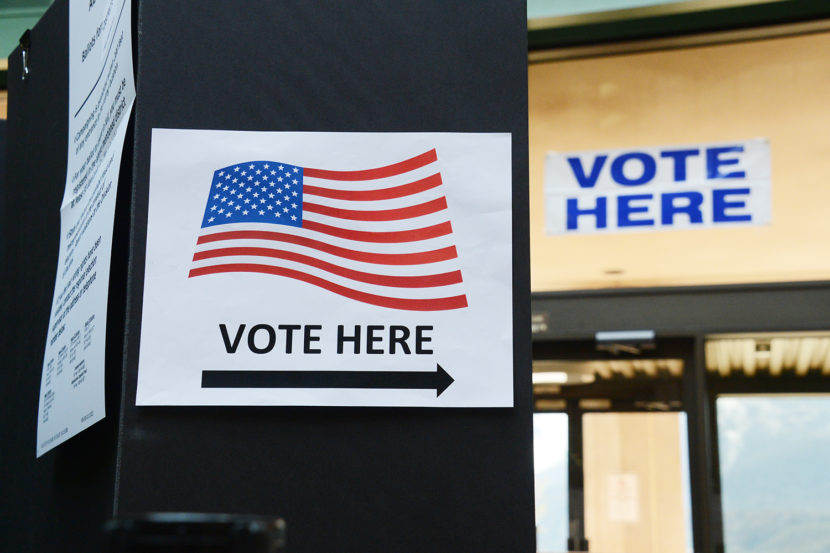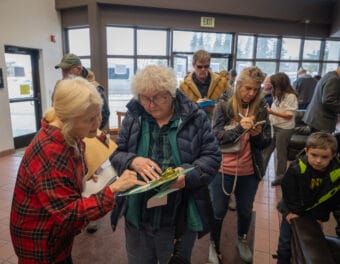
When the polls close at 8 p.m. Tuesday for Alaska’s primary election and the special U.S. House election, Alaska starts a wait of more than two weeks for the final result.
The state’s first-ever ranked choice election, which will decide who represents Alaska in the U.S. House until January, will be finalized Aug. 31, the last date that mailed-in ballots can arrive from Alaskans overseas and still be counted.
Though there’s weeks to go, some results will be released late Tuesday night, and political consultants say there’s some things to watch for.
Expect Peltola to take an early lead, but it may not last
On Tuesday night, said political adviser Jim Lottsfeldt, the “conventional wisdom” is that Democratic candidate Mary Peltola will be leading the special election, followed by either Republican Nick Begich III or Republican Sarah Palin.
That’s been indicated by the few available public polls of the race.
Though we won’t yet know the end result of the new ranked choice voting system, the Alaska Division of Elections has said it will publish the first choices of Alaska voters after polls close on election day.
Alaska has many more Republican and Republican-leaning voters than Democratic and Democratic-leaning voters, but Republican votes will be split between two candidates, likely giving Peltola an early lead, but not one large enough to clinch victory outright by taking more than 50% of the first-choice votes.
Mailed ballots will arrive through the 31st and could change the ranking, but if Peltola is leading, the experts say to look at second place for hints at what happens next.
Who’s in second place?
Under the ranked choice system, if no one has more than 50% of the vote, the person with the fewest first-choice votes is eliminated from contention first.
Anyone who voted for the eliminated candidate then has their votes go to their second choice.
But what happens if voters don’t have a second choice?
In that case, there are fewer votes needed to reach 50%.
Here’s a hypothetical. Imagine 100 people are voting, and the vote splits 40-32-28. The 28 votes are redistributed, and if they all go to the person in second, the split is 40-60 and the second-place person wins.
But if those 28 voters don’t rank a second choice, the final tally stays 40-32, and the person in first place wins.
“The big thing — but we’re not going to know (on Tuesday) is how many people actually elected to rank,” said Sarah Erkmann Ward, who has advised some Republican candidates this year.
The Alaska Republican Party has been running a campaign to prevent that circumstance, telling voters to “rank the red” and to leave Peltola off the ballot entirely.
That effort has been undercut by former President Donald Trump, who has urged voters to rank only Palin. The candidate recorded herself early voting, and her ballot had only one mark, that for her.
Some Nick Begich voters have also said that they will not rank Palin.
Tom Anderson of Optima Public Relations has advised Palin’s campaign and said he believes supporters of both Republicans will leave their second choices blank, and some may choose to write in Tara Sweeney, a Republican who missed the cutoff in the June special primary election.
If the Republican running in second doesn’t get a significant boost from the Republican running in third, Peltola could win.
The likelihood of that happening will depend in part on how wide the margin is on election night. If Peltola has more than 40% of the vote and both Republicans are below 30%, it creates a gap that is more difficult to overcome.
Tom Begich, the Alaska Senate’s Democratic minority leader and an uncle to Republican candidate Nick Begich III, noted that about half of voters in last year’s ranked choice election for New York City mayor didn’t fill out their entire ranked choice ballot.
Statistics published by FairVote, a national organization that supported the installation of ranked choice voting in Alaska, noted that 13% of voters in that election chose only one candidate.
FairVote also noted that in 522 ranked choice races since 2004, the candidate with the most first-choice votes has won 96% of the time.
How will primary candidates perform?
The special U.S. House election is only one side of the ballot. On the other side are the primary races for U.S. Senate, governor, state House and Senate, and the full two-year U.S. House term.
Up to four candidates will advance from each primary to the Nov. 8 general election.
In the race for U.S. Senate, Republican challenger Kelly Tshibaka and incumbent Sen. Lisa Murkowski have raised large amounts of money and campaigned aggressively. Democratic candidate Pat Chesbro has the label of a major party.
All three are expected to advance in the primary, and it’s possible that Tshibaka finishes ahead of Murkowski in the primary.
Lottsfeldt, who operates an organization backing Murkowski, downplayed that possibility, saying it would be akin to Murkowski losing the 2010 Republican primary. (She went on to win the general election with a write-in campaign.)
It’s not known who the fourth candidate will be, and there’s a wide range of possibilities, including a Libertarian and a series of independents.
In the governor’s race, incumbent Republican Mike Dunleavy, Democratic candidate Les Gara and independent Bill Walker are all expected to finish among the top four, and there’s a competition between two Republicans — Charlie Pierce of the Kenai Peninsula, and Christopher Kurka of Wasilla — to fill the fourth spot.
What do the legislative results look like?
In all but one of the state legislative races on the ballot, there are four or fewer candidates for office. That means someone is eliminated in only one race — the one for House District 35 in Fairbanks.
That race features two Republicans, two Democrats and a member of the Alaska Constitution Party.
“There is almost a sigh of relief from all of our clients that there’s not a primary battle,” said Anderson, who is advising many Republican and Republican-leaning candidates.
Joelle Hall, president of the Alaska AFL-CIO, said there are some places where primary results may matter. In districts dominated by one party — she offered downtown Anchorage’s firmly Democratic House District 17 as an example — the electorate may not change between August and November.
A victory by Democratic candidate Harriet Drummond or Democratic candidate Zack Fields in that district would be a stronger signal of victory in November, she said.
For other legislative seats, the noncompetitive primaries are effectively an August opinion poll. A close margin indicates — but doesn’t guarantee — a close race in November.
Anderson, who is advising many Republican and Republican-leaning candidates, said he expects lots of close results.
“What we are seeing unfold in a lot of state legislative races is a very competitive environment, because you have incumbents at the municipal, borough and state level running against other incumbents,” he said.
He pinpointed the state Senate race in Fairbanks between Republican Jim Matherly and Democratic incumbent Scott Kawasaki, and the state Senate race in Anchorage between Republican incumbent Mia Costello and Democratic challenger Matt Claman, a sitting member of the state House.
If a legislative candidate walks away from the primary with 70% of the primary voters, Erkmann Ward said, “that’s a really good indication that they’re well positioned to win in the general. If it is a nail-biter, then we won’t have much more insight other than it’s going to be a very close race.”
What does turnout look like?
All of this comes with a big caveat, experts say. Turnout in primary elections is typically lower than it is in November, and primary voters are typically more partisan.
The fewer people who vote on or before Tuesday, the less representative August’s results will be of November’s outcomes.
“If the turnout numbers are 30% or lower, that implies fairly low interest in the election, which doesn’t necessarily translate into November numbers,” Begich said. “But if the numbers are higher, that’ll be of more interest.”
Lottsfeldt said he is skeptical of drawing conclusions until after the rankings are released on the 31st.
“I think tomorrow’s a big nothingburger,” he said on Monday.
Erkmann Ward noted that this year’s primary elections are open to every voter, unlike past elections that limited participation by party. That’s a point in favor of August working as a preview of November, at least for the U.S. House contest.
“So when we see those percentages come in tomorrow, it should be a pretty good indication of — barring anything dramatic — how this race is going to look going into November,” Erkmann Ward said.
“For things like U.S. Senate, governor, the legislative races, this will be basically a fascinating poll for us to see where everybody’s landing on these candidates,” she said.



